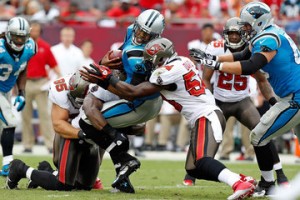Under Raheem Morris, the Tampa Bay rush defense was always… what is the polite way to put this… accommodating to opposing running backs. Over Morris’ three-year tenure, the Buccaneers joined the Bills as either 31st or 32nd in all three major rush defense categories: rushing yards allowed, rushing yards per carry allowed, and rushing touchdowns allowed.
This was the case despite the organization’s best efforts to find players that could stop the run. The Buccaneers’ second selection in the 2009 draft was used on defensive tackle Roy Miller. That season, Tampa Bay finished last in both rushing yards and rushing yards per carry allowed. The following April, the Bucs used the third pick in the draft on Gerald McCoy and the 35th selection on Brian Price, making them the rare team to take multiple interior defensive linemen with top-40 picks. That season was the one successful year of Morris’ tenure, but Tampa Bay still finished 28th in rushing yards allowed and 31st in yards per rush allowed.
So Tampa continued to focus on the defensive line in the 2011 draft, this time taking Iowa’s Adrian Clayborn and Clemson’s Da’Quan Bowers with their first and second round picks and middle linebacker Mason Foster in the third round. In 2011, Tampa finished the year 32nd in rushing yards allowed, 32nd in rushing touchdowns allowed, and 31st in yards per carry allowed.Enter Greg Schiano and defensive coordinator Bill Sheridan. With a horrible run defense for three consecutive years, the Bucs couldn’t ignore the problem just because they had failed in prior attempts to plug the leak. With the seventh pick, the team selected Alabama’s Mark Barron, an in-the-box safety who was considered one of the safest picks in the draft.
Schiano, Barron, McCoy, and second round pick Lavonte David (who was just named the NFC defensive rookie of the month for November) have completely reformed the Tampa rush defense. The team currently ranks first in both rushing yards and yards per rush allowed. That’s unbelievable. Nothing more could be said about the magnitude of a leap from 32nd to 1st, so let me close with a look at the biggest jumps in rushing yards allowed and rushing yards per carry allowed in NFL history.
Biggest improvement in Rushing Yards Allowed Rank:
Biggest improvement in Rushing Yards Per Carry Allowed Rank:

